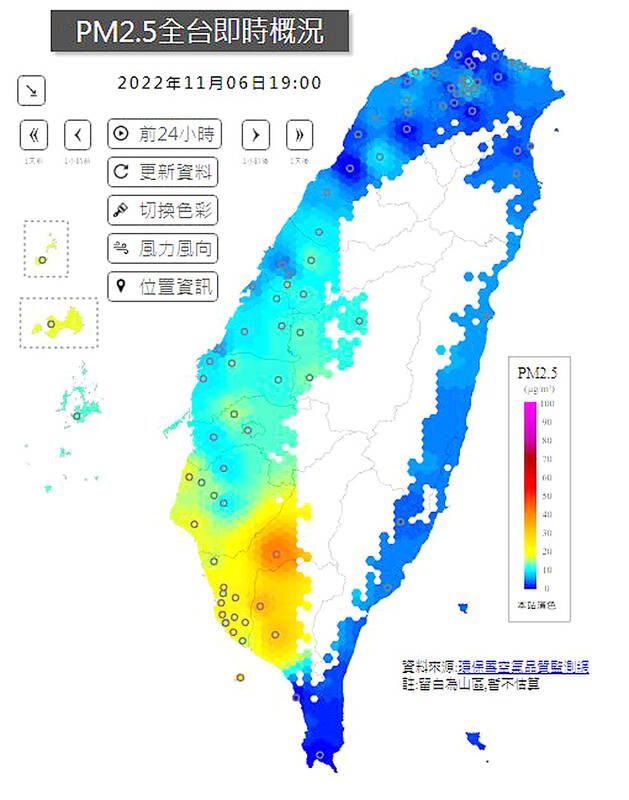People should avoid vigorous outdoor exercise and use air purifiers indoors during peak PM2.5 pollution, as breathing polluted air could lead to liver and kidney injury in the long term, experts said, citing studies.
Yuan Chung-shin (袁中新), a distinguished professor and director at National Sun Yat-sen University’s Institute of Environmental Engineering, and Cheng Fu-jen (鄭富仁), a doctor at Kaohsiung Chang Gung Memorial Hospital’s Department of Emergency Medicine, have published their findings in the journals Science of the Total Environment and Ecotoxicology and Environmental Safety.
A research team led by Yuan and Cheng collected airborne particulate matter smaller than 2.5 micrometers (PM2.5) near Kaohsiung’s Linhai Industrial Park (臨海工業區) to study the effects of PM2.5 constituents on the livers and kidneys of laboratory mice.

Photo: Screen grab from the Environmental Protection Administration Web site
Studies have shown that PM2.5, which is listed by WHO as a Group 1 carcinogen, could harm the lungs and heart.
The team separated PM2.5 into water extracts and insoluble particles, to which mice were exposed by intratracheal instillation.
Exposure to water extracts and insoluble particles led to abnormal liver function and kidney injury, Cheng said.
Insoluble particles caused inflammation in the liver, while water extracts induced cellular proliferation, which showed that different components of PM2.5 pose different health risks to the organ that removes toxins from the blood, he said.
Water extracts and insoluble particles both caused inflammation and injury in the kidneys, he said, adding that PM2.5 might impair kidney function, which could lead to high blood pressure and constricted blood vessels.
The mice were exposed to 40 micrograms of pollutants per week, similar to what they would have inhaled in Kaohsiung during winter, Yuan said.
It was challenging to collect particulate matter, as the team had to take into consideration the wind direction and the matter’s concentration in the air, which is higher in spring and winter, but lower in summer and fall, he said.
It took four sampling machines operating continuously for a month to collect 30,000 micrograms of PM2.5 for the experiment, he added.
Water extracts of PM2.5 mainly include titanium, vanadium, nickel, lead, sulfate and nitrate, while insoluble particles mainly include organic carbons, elemental carbons, heavy metals and other chemicals, he said.
“We might inhale some of the toxic elements while breathing,” he added.
PM2.5 could cause acute asthma attacks and aggravate chronic obstructive pulmonary disease, he said, adding that long-term exposure could increase the risks of lung cancer, and kidney and liver injury through the circulatory system.

An essay competition jointly organized by a local writing society and a publisher affiliated with the Chinese Communist Party (CCP) might have contravened the Act Governing Relations Between the People of the Taiwan Area and the Mainland Area (臺灣地區與大陸地區人民關係條例), the Mainland Affairs Council (MAC) said on Thursday. “In this case, the partner organization is clearly an agency under the CCP’s Fujian Provincial Committee,” MAC Deputy Minister and spokesperson Liang Wen-chieh (梁文傑) said at a news briefing in Taipei. “It also involves bringing Taiwanese students to China with all-expenses-paid arrangements to attend award ceremonies and camps,” Liang said. Those two “characteristics” are typically sufficient

A magnitude 5.9 earthquake that struck about 33km off the coast of Hualien City was the "main shock" in a series of quakes in the area, with aftershocks expected over the next three days, the Central Weather Administration (CWA) said yesterday. Prior to the magnitude 5.9 quake shaking most of Taiwan at 6:53pm yesterday, six other earthquakes stronger than a magnitude of 4, starting with a magnitude 5.5 quake at 6:09pm, occurred in the area. CWA Seismological Center Director Wu Chien-fu (吳健富) confirmed that the quakes were all part of the same series and that the magnitude 5.5 temblor was

The brilliant blue waters, thick foliage and bucolic atmosphere on this seemingly idyllic archipelago deep in the Pacific Ocean belie the key role it now plays in a titanic geopolitical struggle. Palau is again on the front line as China, and the US and its allies prepare their forces in an intensifying contest for control over the Asia-Pacific region. The democratic nation of just 17,000 people hosts US-controlled airstrips and soon-to-be-completed radar installations that the US military describes as “critical” to monitoring vast swathes of water and airspace. It is also a key piece of the second island chain, a string of

The Central Weather Administration has issued a heat alert for southeastern Taiwan, warning of temperatures as high as 36°C today, while alerting some coastal areas of strong winds later in the day. Kaohsiung’s Neimen District (內門) and Pingtung County’s Neipu Township (內埔) are under an orange heat alert, which warns of temperatures as high as 36°C for three consecutive days, the CWA said, citing southwest winds. The heat would also extend to Tainan’s Nansi (楠西) and Yujing (玉井) districts, as well as Pingtung’s Gaoshu (高樹), Yanpu (鹽埔) and Majia (瑪家) townships, it said, forecasting highs of up to 36°C in those areas